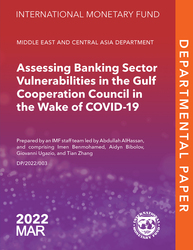
Assessing Banking Sector Vulnerabilities in the Gulf Cooperation Council in the Wake of COVID-19
The Gulf Cooperation Council region faced a significant economic toll from the COVID-19 pandemic and oil price shocks in 2020.
READ MORE...
Volume/Issue:
Volume 2022
Issue 003
Publication date: March 2022
ISBN: 9798400200496
$20.00
Add to Cart by clicking price of the language and format you'd like to purchase
Available Languages and Formats
| English |
Topics covered in this book
This title contains information about the following subjects.
Click on a subject if you would like to see other titles with the same subjects.
Banks and Banking , Money and Monetary Policy , COVID-19 , banking performance , corporates performance , sovereign-banks-economy nexus , bank asset quality , oil price shock , policy support , assessing banking sector vulnerability , C , bank assets quality , Financial statements , Commercial banks , Loans , Credit , Global , Middle East
Summary
The Gulf Cooperation Council region faced a significant economic toll from the COVID-19 pandemic and oil price shocks in 2020. Policymakers responded to the pandemic with decisive and broad measures to support households and businesses and mitigate the long-term impact on the economy. Financial vulnerabilities have been generally contained, reflecting ongoing policy support and the rebound in economic activity and oil prices, as well as banks entering the COVID-19 crisis with strong capital, liquidity, and profitability. The banking systems remained well-capitalized, but profitability and asset quality were adversely affected. Ongoing COVID-19 policy support could also obscure deterioration in asset quality. Policymakers need to continue to strike a balance between supporting recovery and mitigating risks to financial stability, including ensuring that banks’ buffers are adequate to withstand prolonged pandemic and withdrawal of COVID-related policy support measures. Addressing data gaps would help policymakers to further assess vulnerabilities and mitigate sectoral risks.
Copyright © 2010 - 2025
Powered by:
AIDC



